The HobbitHouse Ilustrated Glossary of Woodworking terms
A
B
C
DE
F
GH
IJK
L
M
NO
P
QR
S
T
UVWXYZ
To see general comments about this glossary and for the email address, click here: GLOSSARY
for images of wood itself, go here: wood id site

270 degree hinge --- This refers to a hinge that allows a door to rotate 270 degees and thus allows it to open all the way to the outside side of a cabinet wall. This can only be achieved on a frameless full overlay cabinet design, and is best illustrated graphically, so see below. Note that there are two basic style of 270 degree hinges and the first is shown on the left side of the composite pic below and the other on the right side. Also, note that sometimes these hinges are called wrap around hinges or "wrap around inset" hinges or "double wrap around" hinges or "full back to back wrap around" hinges, but "wrap around hinge" normally means what is shown on that link. Examples:
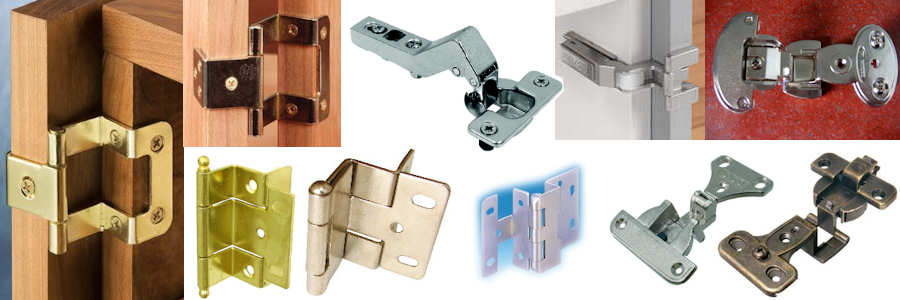
abrasion --- The process of the wearing down of a surface due to rubbing by coarse objects that cause small portions of the surface to be removed. Also refers to the wear marks themselves in addition to the process. Abrasion resistance is an important characteristic of some finishing agents.
abrasion resistance --- The ability of a surface to resist mechanical wear. Abrasion resistance is not necessarily related to hardness as believed by some, but is more clearly comparable with toughness.
abrasive ---[adj] Very rough; causing abrasion.
abrasive --- [noun] A substance that is very rough and which is used to wear down a surface. Sandpaper is an abrasive, as is steel wool.
abrasive belt cleaner --- synonmous with sandpaper cleaner
abrasive cut-off saw --- see cut-off saw
abrasive saw blade --- A circle of material, usually steel, to which is bonded a highly abrasive material (e.g. industrial diamond) such that the blade can be used to cut masonry, glass, metal, and other material that cannot be cut by saw blades designed to cut wood. In some cases, the entire blade may be made from an abrasive material or a composition of fiber with bonded abrasive particles. Most often used in cut-off saws.
abrasive wheel --- synonymous with abrasive saw blade
absolute density --- see density
absorption --- In terms of woodworking, this refers to the process by which wood takes in water or other liquids such as finishing agents). The absorption properties of end grain is generally much stronger than that of face grain or edge grain. Compare/contrast to adsorption
AC --- Alternating Current
accelerator --- any substance that speeds up the curing time of an adhesive (including things as diverse as superglue and caulk) or the drying time of a finishing agent. I have seem some definitions which imply that accelerator is synonymous with catalyst, but that is nonsensical since accelerators tend to be consumed in the reaction that they cause; those definitions were done by folks who don't really understand what a catalyst is.
accent strip --- A strip of wood flooring used in contrasting color to the rest of flooring. Often used around the edges of a room or around a fireplace or other features in order to highlight a specific area.
acclimation --- Letting wood adjust so that its moisture content is in equilibrium with the environment in which it will be installed. This is can be crucial in preventing excessive movement in service due to a change in the relative humidity in the air when the piece moves from the area of fabrication to the area of use. It is always best to manufacture wood products in an environment similar to the one in which it will be used, but this isn't always possible. In fact, it's frequently pretty much IMpossible, given that most wood products could end up anywhere and have to fit widely varying conditions. Still, it is a good goal to keep in mind, particularly for a craftsman building a one-off item for personal use. Once wood has acclimated to its surroundings, it is said to have "ambient moister content".
acetone --- The simplest ketone; a highly flammable organic compound, widely used as a solvent. Readily available, dangerous stuff to have around but it really cuts the grease. Use only with good ventilation and soak rags in water after use. Acetone is recommended for use on oily woods such as teak and cocobolo prior to gluing, the idea being that the acetone will cut way back on the amount of oil present at the surface so that it does not prevent the glue from getting a strong grip on the wood.
acorn nut --- A type of cap nut that is specifically shaped like an inverted acorn, which shape is purely decorative, not functional. Examples:
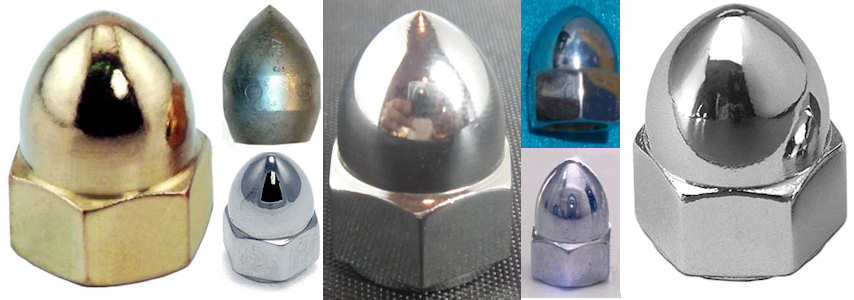
acoustic tile --- Panels of very lightweight, porous, material designed to be used in dropped ceilings both for their acoustic properties (they dampen sound somewhat) and because of their light weight.
across the grain --- The direction at right angles to the length of the longitudinal elements (fibers and/or vessels) of wood.
acrylic --- This refers to both a finishing agent in its own right and a chemical compound that is used in some other finishes. In its own right, acrylic is a very heavy, normally thickly applied, plastic coating. In an extreme form, I have seen it used in a seafood restaurant to cover a wood table on top of which ropes had been coiled and then the whole thing was given a flat surface by flooding it with acrylic. Compare/contrast to other finishing agents.
activator --- The curing agent of a two component/compound adhesive system such as 2-part epoxy.
actual size --- This is the "actual size" discussed with the term nominal size. Also called the "dressed size".
AD --- Air Dried
adhesion --- The property causing one material to stick to another; the strength with which an adhesive acts.
adhesive --- A substance that is capable of bonding two materials together by surface attachment. Types include cement, mucilage, paste, and glues. The most common adhesive for woodworkers is "yellow glue" aka "carpenter's glue" (chemically, polyvinyl acetate) sold in all hardware stores. A stronger version is sold as "tightbond", which is polyvinyl acetate that cross links to form a stronger bond that is water resistant and resists creep over time. For woodworking, there are numerous specialty adhesives such as waterproof glue for outdoor use, hide glue, and on and on. Considerations for choosing an adhesive include setting time, expansion/contraction during curing, working time, ease of cleanup, shelf life, activation method (air, moisture, heat, etc), creep (movement after curing), amount of clamping required, etc.
Most woodworking glues do not list the chemicals used in the glue, making comparisons difficult even if you understand the implications of the presence of various chemicals. Selection of the proper adhesive for the job at hand can be a critical choice, so the wise woodworker will learn something about the various kinds available.
adhesive joint --- (1) A joint that uses an adhesive instead of nails or screws. Compare/contrast to dry joint. In normal use, this term is used as synonymous with glue joint (a more-often used term) even if the adhesive is not glue.
adhesive joint --- (2) The location at which two objects are held together with a layer of adhesive.
adjustable dado blade --- The dado is one of the simplest and most widely used joints in woodworking and since it cannot be made with a single pass of a normal circular saw blade, special dado cutter blades have been developed. There are two fundamental types, the adjustable dado blade which is discussed here and the stacked head dado cutter which is discussed as its own term in this glossary. The adjustable dado blade is a slightly complicated device which consists of a circular saw blade that has an adjustable angle so that it wobbles by an adjustable amount and thus cuts a dado groove of whatever width is set; sometimes there is more than one blade, but the adjustable wobble is always part of the mechanism. This is a somewhat sloppy solution because it does not produce perfectly vertical groove walls nor does it produce a perfectly flat groove bottom although neither are off by any significant amount. There is one version, shown in the far left in the composite pic below, that is actually more like a stacked head dado with chippers plus adjustable shims so that it does not suffer the disadvantages of the more common adjustable dado blades. Also called a "wobbly head" dado cutter. Examples:
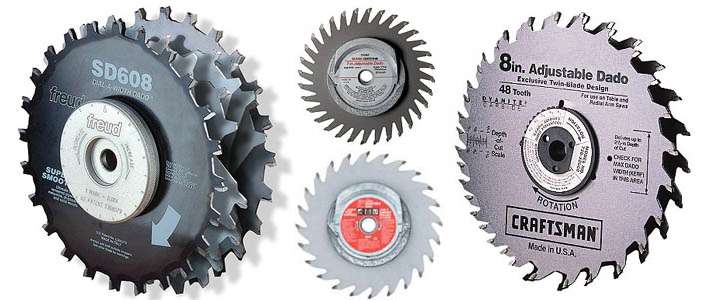
adjustable spade bit --- A spade drill bit that has an adjustable slider rather than a fixed bottom, thus allowing variable sized holes to be drilled, albeit not with as flat a bottom as with a fixed spade bit. Examples:
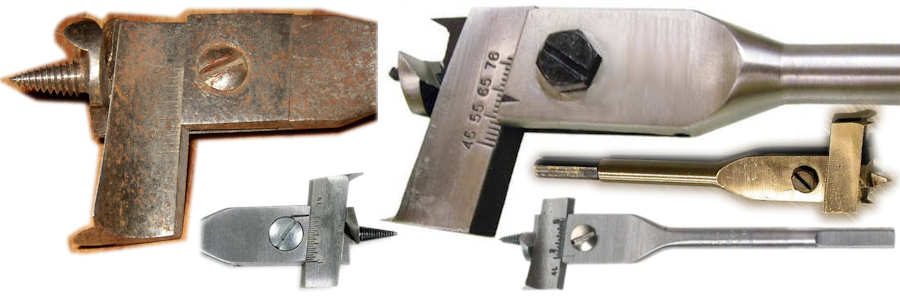
adsorption --- The adhesion of molecules of a liquid or gas to the surface or a solid. This is a weak bond and is generally much weaker and less permanent than absorption. In terms of woodworking, it has to do with the bonding of sprayed finishing agents.
adult wood --- synonymous with mature wood
advanced decay --- The later stage of decay in which destruction is readily recognized by soft, pitted, or crumbly areas, frequently accompanied by obvious discoloration of the wood.
adze --- A "scooping out" tool that is a bit like a hatchet but with the blade turned perpendicular to the direction of stroke rather than parallel as in an axe. Such tools have been in use from early human history, with the earliest ones made of stone. Modern ones may have a flat striking head on the reverse side, or no striking surface there at all, or a pointed gouging tool, or may be extended to a full hammer head. The cutting edge can be flat, or slightly curved, or highly curved and the blade can also be flat or curved. The handle can be short like a hatchet or long like an axe. They are used for, among other uses, scooping out wood from a log to make a canoe, or for roughing out a seat bottom (which would then likely be scooped out more precisely with a scorp), or for roughing out a bowl. Examples:
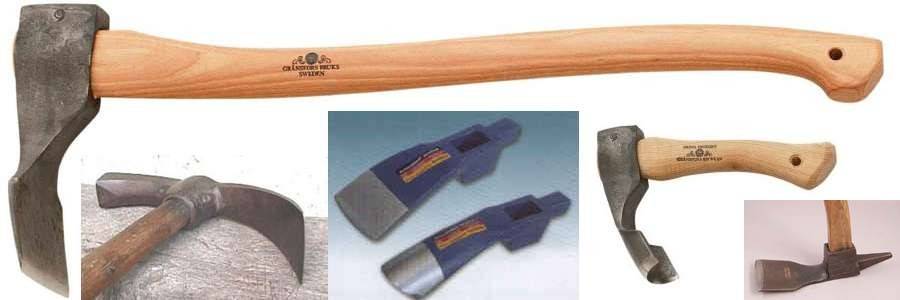
AFA --- American Forestry Association
afforestation --- [also forestation] The establishment of forest crops by artificial methods, such as planting or sowing, on land where trees (1) have never grown or (2) from which they were stripped at least 50 years previously (although the latter is generally called reforestation) although that term does not imply any time limit.UNCLEAR???
A frame --- Any construction based on two independent beams fastened together at the top and separated widely at the bottom so as to form the letter "A". Normally there are a series of such constructs and taken together they form the roof/walls of the structure. A sawhorse consists of two simple A-frames joined by one beam.
age class --- Any interval into which the age range of trees, forests, stands or forest types is divided for classification and use. Forests are commonly grouped into 20-year age class groups; that is, a stand of trees would be considered a single age stand if all of the trees were within 20 years of each other in age.
aggregate --- A component of a composite material used to resist compressive stress, most particularly concrete. Aggregate should be much smaller than the finished item and have a wide variety of sizes. For example, the particles of stone used to make concrete typically include both sand and gravel. Some commonly used aggregate materials include crushed stone, gravel, lava rock, and sand.
aggregate coated panel --- A panel with stone chips and/or other aggregate material embedded in a resin coating. Such panels of often used for interior decoration to give an exterior look such as on a wall that has a fireplace in it.
air bubbles --- The inclusion of trapped air bubbles in a finishing agent. Often caused by applying the finish too heavily, or because of excessive brushing. The process of brushing can cause air bubbles. Air bubbles are undesirable because they give the finish an uneven look and if they are big enough and are popped later, then they give a finish a rough feel as well as an uneven look. When applying finishing agents, wiping is better than brushing for avoiding air bubbles.
air cleaner --- As regards woodworking, this is synonymous with see dust collector
air dried --- Wood that has been dried by exposure to the open air without artificial heat or dehumidification, normally for months or even years, as opposed to being dried in a kiln (kiln dried). Air drying is normally done out of doors under a roofed area without sides, to avoid too much rainfall and/or direct sunlight on the lumber but to allow free flow of air. With air drying, the wood moisture content is brought to equilibrium with the surrounding atmosphere (when it is then said to have "ambient moisture content"), so "air dried" in a rain forest area is going have a significantly different meaning than "air dried" in the Nevada desert. In other words, the moisture content of air-dried wood fiber depends on relative humidity, temperature, and length of drying period, and thus may NOT mean that the wood has been dried sufficiently to go into service. This is opposed to kiln dried, which implies that the wood HAS been dried sufficiently to go into service. Most reports say that air dried wood should have between 12% and 20% moisture content (wood above 20% MC is subject to decay). Also referred to as air seasoned. Compare/contrast with kiln dried. It is generally agreed that to reach serviceability, planks should be air dried for approximately one year for each inch of thickness. Note that no matter what the drying technique, wood that has once been properly dried is NOT forever dried; it can absorb sufficient moisture from the air to no longer be sufficiently dry to be put into service.
air drying --- (1) As regards wood, see air dried
air drying --- (2) A common form of curing a finishing agent in which drying takes place by oxidization or solvent evaporation by simple exposure to air without heat or any catalyst.
airless spray --- A spraying system for finishing agents in which a coating is atomized using high fluid pressure rather than compressed air.
alcohol --- A group of solvents of relatively high evaporation rate but with fairly low solvent strength. Commonly used as a solvent in shellac, some stains, dyes, inks, and lacquer. Alcohols include Methanol, Ethanol, Isopropanol, n-Butanol, Isooctanol, Methyl Isobutyl Carbinol, Isoamyl Alcohol, Isobutyl Alcohol, Cyclohexanol, and Methyl Cyclohexanol.
algae --- any of several divisions of simple photosynthetic organisms containing chlorophyll and other pigments and having no true root, stem, or leaf. They are mostly found in water ("pond scum" is algae) but can grow in any damp place such as marine pilings, and even house roofs and siding if the conditions are right. I recently replaced the roof on my garage because it was so old that the plywood had rotted in places where the shingles had failed and the shingles on the side that got very little sunlight (and thus stayed wet longer after a rain) were green with algae.
all aged stand --- A stand of trees in which all, or almost all, age classes of trees represented.
Allegany hardwood forest type --- A forest type in the Northeastern United States; it includes black cherry, white ash, and red oak.
Allen head --- A type of screw or bolt head that is designed for use with an Allen wrench.
Allen head bolt --- A bolt with a hexagonal recess in the head requiring an Allen wrench , often used in woodworking machinery, among many other things. These may be in metric or SAE sizes. These are usually made out of strong steel, but occasionally you may find them in lighter grade steel or even aluminum. Allen head recesses are also used extensively in set screws. Other names for this item are "socket cap screw", "socket screw", and "socket head cap screw". Examples:
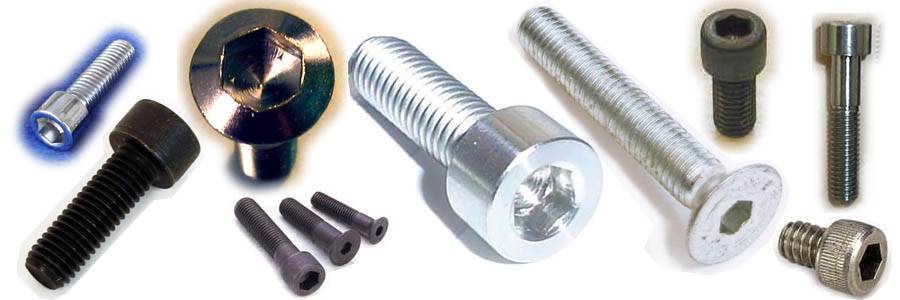
Allen wrench --- A type of wrench that is a hexagonal-shaped metal bar, usually in the shape of an "L" but sometimes in the shape of a "T" and sometimes with a handle like what you find on a screwdriver but more often with a handle on the "T" portion, used to turn Allen head bolts and set screws. These may be in metric or English sizes and are sold both in sets and individually. Examples:
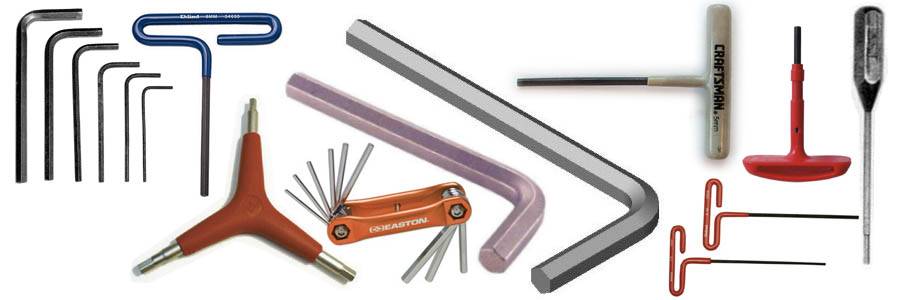
all heart --- Refers to lumber that is pure heartwood (or, said the other way round, contains no sapwood.
alligatoring --- A form of paint failure in which cracks form on the surface layer only. It is caused by the application of a hard drying paint over a relatively soft paint or by the application of thick films, in which case the underlying surface remains relatively soft. It is also caused by the application of paint over unseasoned wood. As the name implies, an alligatored surface is one that resembles the hide of an alligator because it is cracked into large segments. As the surface of the thick film dries it tends to shrink and the soft, undried, under layers allow the surface film to shrink thereby causing the alligatoring. Also called checking.
allowable span --- The span that is considered safe for a given structural member such as a joist, rafter, beam, or girder.
alloy --- A mixture of two or more metals to create a composition with specific properties. For example, brass is an alloy of copper and zinc.
all thread --- see drill rod
alternating current --- [AC] The kind of electrical power you get from a wall socket. So-called because the electrical current alternates directions. AC power is used to drive all woodworking tools that you plug in the wall. Battery-driven tools run on direct current.
amber --- [noun] A yellowish translucent resin formerly used in the manufacture of varnish, but now very scarce and expensive.
amber --- [adj] An orangish color found in some resins and varnishes.
ambient moisture content --- The moisture content of wood when it has come into equillibrium with the ambient humidity and temperature. Also called equilibrium moisture content.
ambient temperature --- The existing temperature of the surroundings. The relevance to woodworking is that you might see the term in a discussion of movement in service with is mostly dependant on relative humidity which in turn is somewhat dependant on temperature.
ambrosia --- (1) The name of a beetle that attacks some woods, particularly maple. Interestingly, this "group" of beetles is NOT a taxonomic group but rather a diverse range of otherwise unrelated beetles that share the characteristic that they have a symbiotic relationship with a particular fungus, called ambrosia fungus. It is this fungus that causes the discoloration found radiating up and down the grain from the holes that the beetle creates as it bores into the wood. Further, the beetles don't eat the wood, they excavate it; their point in digging into the wood is to deposit their larvae. These beetles do not normally kill the trees they bore into, but if a sufficiently large number of them use one tree, they can kill it because the fungal growth clogs up the flow of tree nutrients.
ambrosia --- (2) Wood attacked by the Ambrosia beetle, which leaves holes, around which there is a heavy discoloration of the wood caused by the fungus that lives in symbiosis with such beetles. This is something that happens most often in maple. I cannot at the moment think of any other species that it happens to but from all reports, these beetles burrow into lots of different types of trees. Here is a pic showing ambrosia maple in various forms. These planks and turnings all have a relatively high density of markings; it is more normal to see ambrosia maple with considerably fewer markings per area of wood than this, and solid wood with heavy ambrosia markings is highly prized by wood turners.

AMC --- Ambient Moisture Content
American Forestry Association --- [AFA] A volunteer organization established in the United States in 1875 and currently with headquarters in Washington, D.C.. The organization acts as a clearinghouse for environmental organizations working to preserve world tree growth. The "National Register of Big Trees" keeps track of tree growth and potential damage from environmental pollution. The Association publishes the magazine, American Forests and Forest Life, and members include the executive director of the Boy Scouts of America, railroad officials, the president of the American Federation of Labor, officers of farmers' organizations, deans of forestry schools, governors, the presidents of the American Federation of Women's Clubs and of the League of Women Voters, and the chief forester of the National Forest Service.
American Lumber Standard Committee --- A non-profit organization made up of manufacturers, distributors, users, and consumers of lumber. It serves as the standing committee for the American Softwood Lumber Standard and administers an accreditation program for the grademarking of lumber produced under that standard.
American Society for Testing and Materials --- [ASTM] An organization that sets standards for a wide variety of materials, including roofing.
American Softwood Lumber Standard --- [ASLS] A publication of the National Institute of Standards and Technology (NIST, formerly the National Bureau of Standards, or NBS). This is a "voluntary" standard, which means it has no force of law (except as incorporated in commercial contracts), but it is nonetheless widely accepted and used by industry in the USA. The current version of this publication is PS 20-05, Sept 2005. and it is available online. The standard is maintained and updated as needed by the American Lumber Standard Committee, and is an integral part of the lumber industry's economy and is the basis for the sale and purchase of virtually all softwood lumber traded in North America.
American Wood Preservers Association --- see American Wood Protection Association
American Wood Protection Association. --- [AWPA] Founded in 1904 as the "American Wood Preservers' Association", this is a non-profit organization that promulgates voluntary wood preservation standards. AWPA Standards are developed by its technical committees that include members from numerous American industries that have an interest in wood and wood products. AWPA's voluntary standards, which are specified for wood preservation in the USA (and are recognized worldwide) help ensure that treated wood products perform satisfactorily for their intended use. They are recognized and used by most, if not all, specifiers of treated wood throughout American industry, as well as by local, state and federal governments. The standards development meetings are open to all persons whether or not they are members of the Association.
ammonia --- A pungent gas compounded of nitrogen and hydrogen that is used in woodworking in the process of fuming wood.
anchor bolt --- A device for connecting timber members (or anything else, for that matter) to concrete or masonry. There are numerous styles, some of which involve drilling a hole in the concrete or masonry (in particular, see expansion anchor bolt) and some of which involve embedding the bolt in concrete when it is poured so the bolt is in place when the concrete sets and the wood (or whatever) that is to be attached is drilled out and then placed over the bolt and attached with a nut. Anchor bolts are used for, among other thing, fastening the sill plate in a frame construction to the foundation. To prevent the plate timber from splitting, the anchor bolt nut is often put down over a plate washer. Examples of the most common type of anchor bolt which is an "L" shaped metal rod, threaded on the longer end:

anchor hinge --- A particularly strong type of door hinge that has flaps on the (hinge) leaves to give extra attachment points to the door and frame; the flaps attach horizontally along the top edge of the door and the top surface of the frame. Most have these flaps on both leaves, but some (e.g. the two on the right side of the pic below) only have it on the frame leaf. Examples:
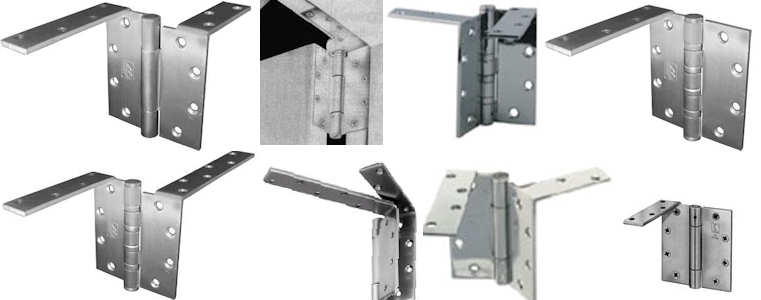
anchor piece --- When two pieces of wood are joined with a screw, the screw goes through one piece, which is called the "captive piece" and into the other, which is called the "anchor piece".
anchor plate --- (1) A large plate or washer connected to a tie rod or bolt. Anchor plates are used on exterior walls of masonry buildings, for structural reinforcement. Being visible, many anchor plates are made in a decorative style.
anchor plate --- (2) A metal plate, with a ring or semi-circle in it, that is bolted to a concrete or masonry foundation and acts as an anchor for something.
Examples of definition 1:
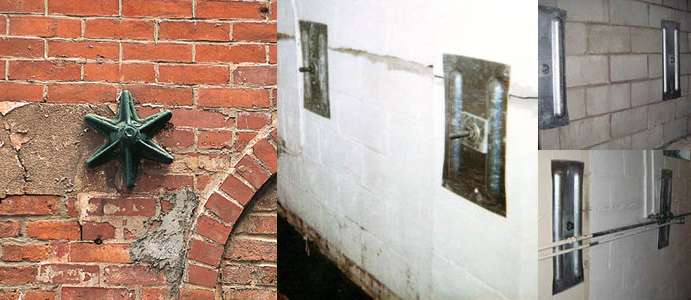
Examples of definition 2:

angel step --- Cutting across stumps of trees sometimes produces a staircase-like, somewhat curly figure, that is commonly called "angel step". This occurs most frequently in walnut, but may occur in other woods such as ash and maple. When book-matched, this figure can be particularly dramatic. For pics of several examples, see angel step pics. Here is a pic of (1) bookmatched angel step maple, (2) angel step walnut, and (3) angel step maple:

angiosperm --- A member of the seed plant class whose seeds are enclosed in ovaries; that is, these are in one form or another, flowering plants. There are two main subclasses: the subclass dicotyledons (aka dicots) includes all hardwoods trees and the subclass monocotyledons (aka monocots) includes palms and bamboo, both of which are technically grasses, not wood. Although angiosperms have flowers, many of them are not showy or colorful in the way that humans tend to think of flowers. They also tend to have nuts, drupes, berries, winged fruit, and other fruit types. They tend to have broad leaves in general, with some exceptions in exotic species. For the most part, the leaves drop off in the fall (they are said to be deciduous) but some gymnosperms (e.g. bald cypress and larch) are deciduous, while many hardwoods (e.g. some oaks) in both tropical and temperate climates are evergreen, so leaves alone don't make the distinction between hardwoods and softwoods. Contrast with gymnosperm.
angled crossed full lap --- A full lap joint where the two planks meet at an angle other than 90 degrees and fully cross each other. Examples:
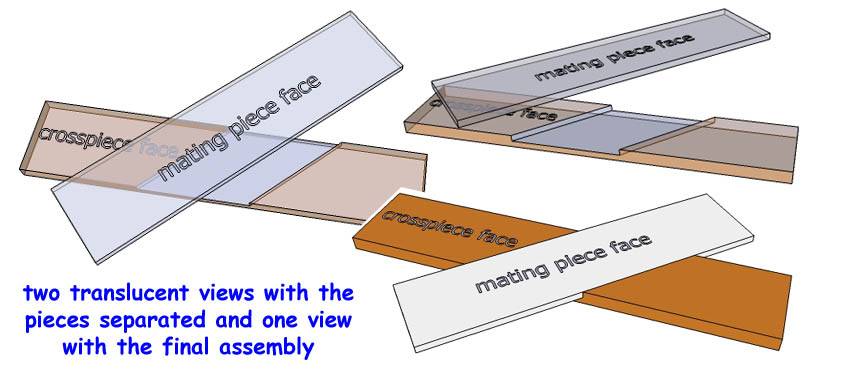
angled crossed half lap --- A half lap joint where the two planks meet at an angle other than 90 degrees and fully cross each other. Examples:
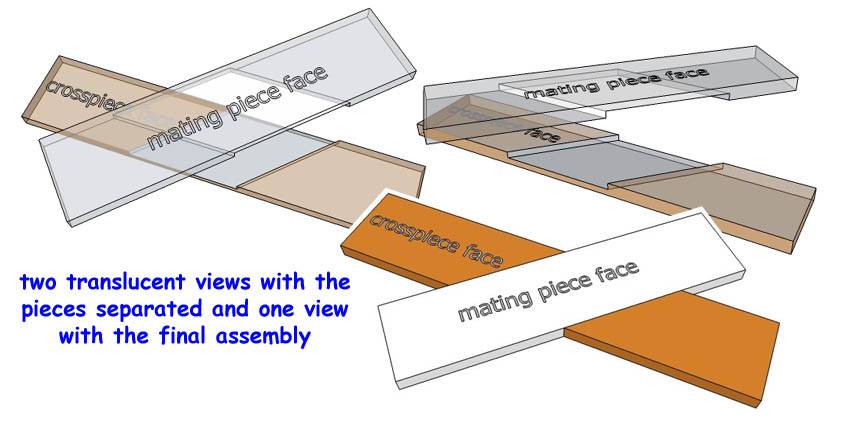
angled dovetailed full lap --- A dovetailed full lap joint where the mating piece comes into the cross piece at an angle other than 90 degrees. As shown in the examples below, the joint can be either half blind or through. Examples:
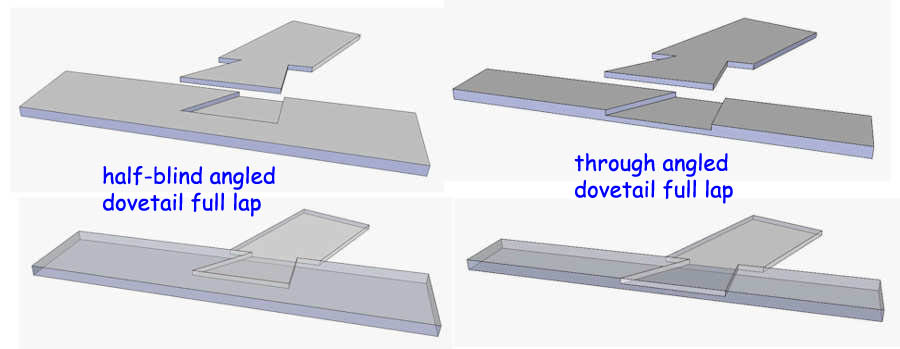
angled dovetailed half lap --- A dovetailed half lap joint where the mating piece comes into the cross piece at an angle other than 90 degrees. As shown in the examples below, the joint can be either half blind or through. Examples:
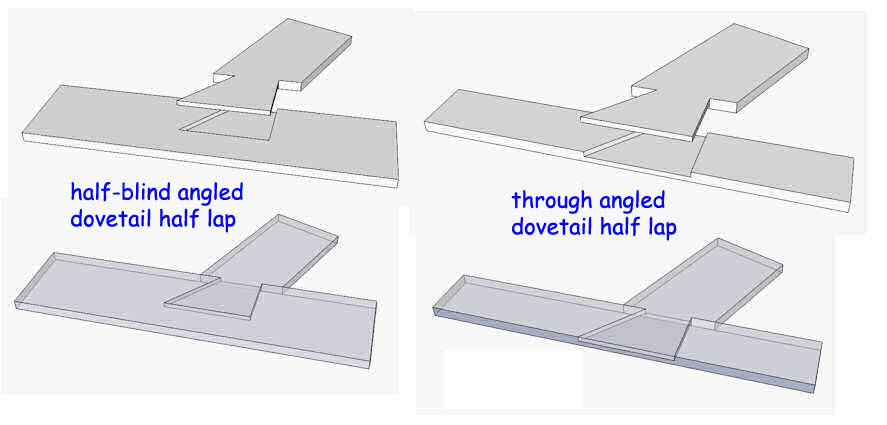
angled full lap --- A full lap joint where the pieces meet at an angle other than 90 degrees. As can be seen in the examples below, the joint can be half blind or through. Examples:
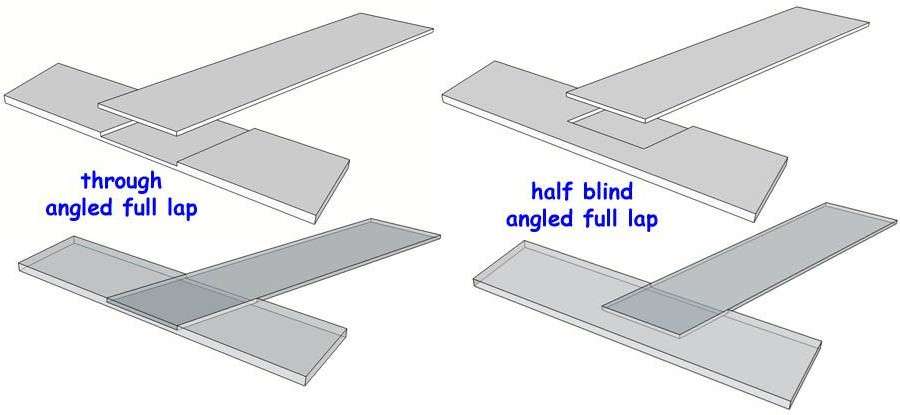
angled half lap --- A half lap joint where the pieces meet at an angle other than 90 degrees. As can be seen in the examples below, the joint can be half blind or through. Examples:
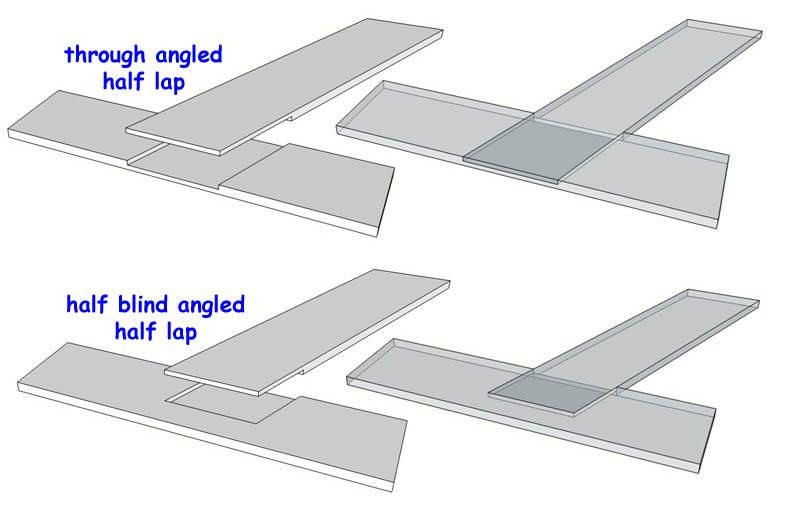
angled haunch --- see sloping haunch
angled keyed dovetail full lap --- A keyed dovetail full lap joint where the mating planks meet each other at an angle other than 90 degrees. As can be seen in the examples below, the joint can be half blind or through. Compare/contrast to angled dovetail full lap. Examples:
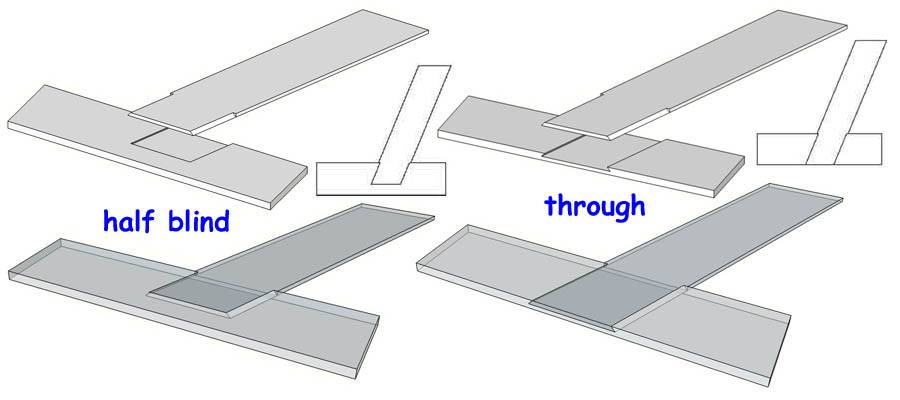
angled keyed dovetail half lap --- A keyed dovetail half lap joint where the mating planks meet each other at an angle other than 90 degrees. As can be seen in the examples below, the joint can be half blind or through. Compare/contrast to angled dovetail half lap. Examples:
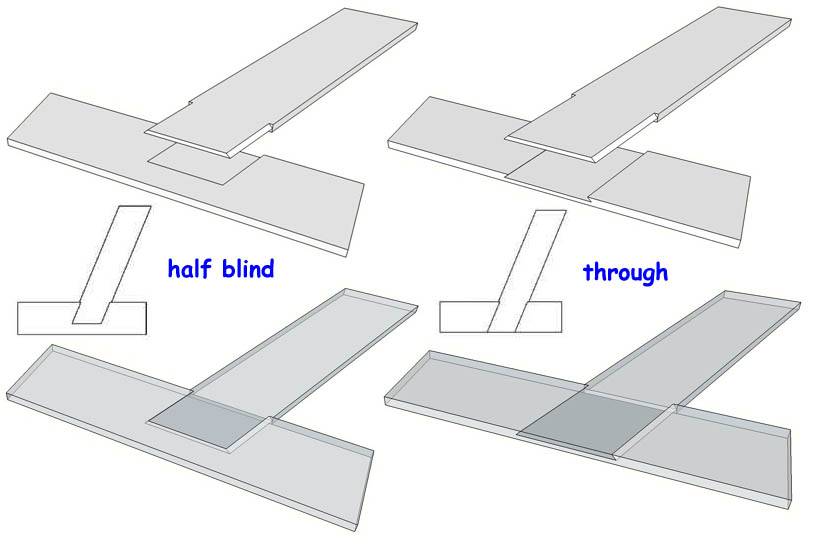
angled mortise and tenon --- A mortise and tenon joint that uses an angled tenon. See "angled tenon" for an illustration.
angled shoulder mortise and tenon --- A frame joint but with the two planks meeting at an obtuse angle, and a type of mortise and tenon joining the two. The joint can be done with a loose tenon as in the example below, or with a standard tenon coming off of the upper piece but complicated somewhat because of the angles involved. Such a joint could be used to make a picture frame shaped like a parallelogram, but a more likely example would be joining a banister with a newel post. Example:
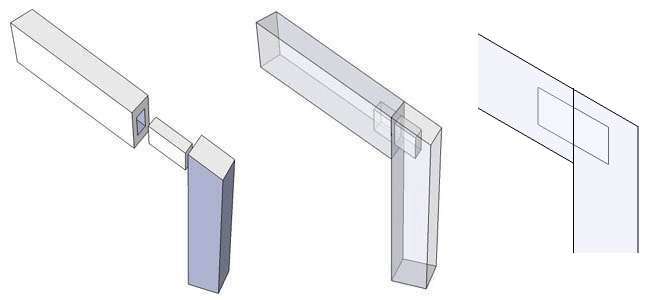
angled tenon --- A tenon that projects out from the surrounding piece at an angle other than 90 degrees. Such tenons are used in a normal mortise and I have never seen reference to a joint where the mortise is angled. Certainly, you could make such a joint but apparently it is either non-existent or so rare that it is not discussed in joinery books. See also mortise and tenon joint. In the example below, the three posts are all 3" square and the stub tenons to the outer posts are 2" long but the tenons to the middle post are each 1.5" long and meet in the middle.
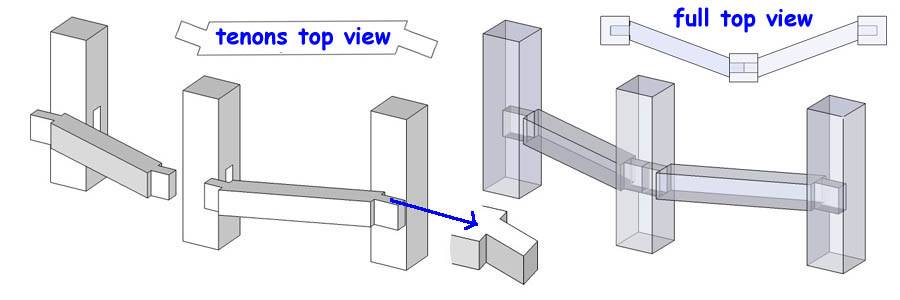
angle grinder --- A handheld power tool that is used for cutting, grinding and polishing and that may be powered by AC, a gas engine or compressed air. The motor drives a geared head that drives a shaft at 90 degrees to the barrel of the tool body. On that shaft is mounted an abrasive disk that can be renewed when worn. Angle grinders typically have an adjustable guard and a side-handle for two-handed operation. The wheels/disks for this tool come in many materials, depending on the desired use. Examples:
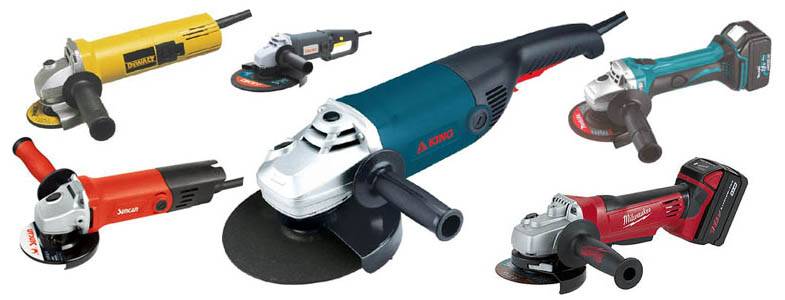
angle iron --- "L" shaped iron rods of varying size and thicknesses, with a huge number of uses, commonly available in hardware stores. Examples:
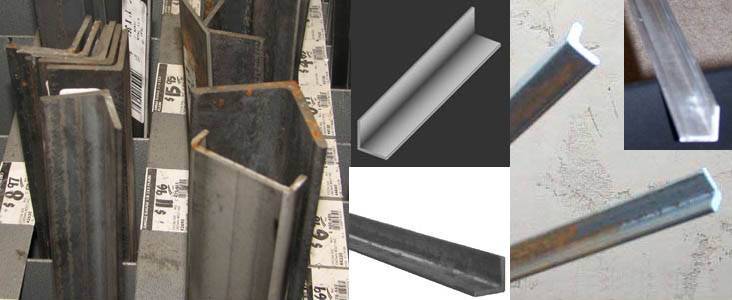
angle of approach --- the angle between a wood carving piece and the tool being used to carve it.
anisotropic --- Exhibiting different properties in different directions. Wood, a material that has fibers and vessels all running in pretty much the same direction are anisotropic because the characteristics along that direction are significantly different than the characteristics perpendicular to that direction. See tree growth for further discussion. The opposite of isotropic.
annual growth rings --- Trees in temperate climates grow at different rates during the seasons, ranging from exuberant early growth in the spring when the sap is flowing in the tree and in the early summer, to a slower late growth in the late summer and fall, becoming more dormant as the winter sets in, to essentially none in the winter itself. The early growth is also called "spring" growth and the late growth is also called "summer" growth. The early growth is typically wider, less dense, weaker, and more porous (in hardwoods) than the late growth and in many cases is significantly lighter in color. These seasonal growth spurts create differing cell structures which, when a tree is cut perpendicular to the axis of growth, show up as what are called "rings", for the obvious reason that they are, geometrically speaking, a series of concentric rings that start at the center of the tree and occur outward, one for every year of the tree's growth. NOTE: false rings occur in some species, sometimes due to a late frost, others due to unknown reasons.
Tree rings can be counted to tell how old a tree is, and the size of the rings can tell a lot about the growth conditions of their year (e.g. drought years as opposed to plentiful rain years). By working with long-dead trees, whose growth rings ended many years ago, and overlapping them with trees whose earliest growth rings happened before the older tree died, scientists have been able to date some events back for several thousand years.
Trees that grow in tropical zones (that is geographic regions where there is little change in climate throughout the year) grow pretty much the same amount every day throughout the year and consequently have little variation in texture. In some tropical zone species (e.g. black gum and sweet gum) and many tropical species, particularly those whose growth ranges do not get too far from the equator, annual growth rings can be anything from very hard to detect to essentially non-existent.
Growth rings have both micro and macro characteristics. The micro characteristic has to do with the SIZE of the pores in the ring (see open pore and closed pore) and the macro characteristic has to do with the SPACING of the rings themselves (see tight grained and loose grained). For more pictures of wood with varying intensities of growth rings, see growth ring pics
annular ring nail --- A nail that has ridges around the circumference of the shank to provide extra holding power for applications such as wood to plywood bonding, flooring, roofing, and use in pallets. Although, as they are driven in, the ridges push the wood fibers aside, after they are in the fibers tend to expand back into the ridges thus giving better holding power than smooth-shank nails. The size and shape of the ridges varies considerably and they are often angled back up the shank so as to act like wedges, and sometimes they are actually tight spirals rather than just circumferential ridges. These nails are particularly susceptible to crippling because all those rings provide multiple points of possible failure. Examples:
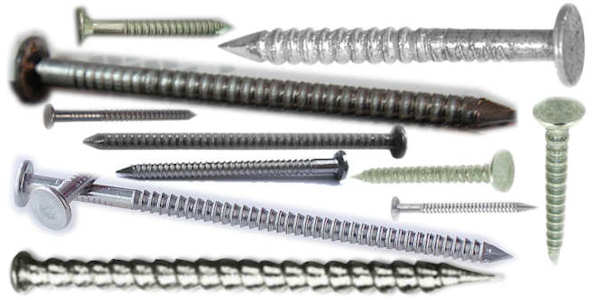
antioxidant --- Any chemical used to retard deterioration of finishing agents caused by oxidation, heat exposure, etc.
APA --- The Engineered Wood Association ("APA" comes from the old name, American Plywood Association). This is the trade organization representing the majority of the North American wood panel manufacturers, as well as I-Joist, glulam and structural composite lumber manufacturers. The Association has three main functions: 1) research to improve structural panels and other engineered wood products and construction systems, 2) quality inspection and testing to assure the manufacture of high quality products that meet the appropriate product standard, and 3) education and promotion of engineered wood products and building systems.
APA panel ratings --- The APA has numerous ratings for various grades and uses of plywood panels but details are beyond the scope of this glossary.
APA trademark --- The trademark used on wood products manufactured by APA members. A sample of such a trademark stamp can be seen on the illustrations that accompany the term oriented strand board
application --- The process by which a finishing agent is put on a surface. Techniques include:
applicator --- A device with which the application of a finishing agent to a surface is accomplished. Examples are brushes, cloth, spray cans, etc.
applied carving --- A wood carving which is worked separately (that is, on a separate piece of wood) and then applied (that is glued on), rather than being worked in place.
apron --- A rail from one leg to another of a table or chair, supporting the table top or chair seat and adding rigidity to the structure. Aprons may be plain wood or may be adorned with carvings or covered with cloth or leather and they may be curved or straight. Examples:

apron flashing --- Flashing used at the joint of a sloped roof and any vertical projection such as a chimney or a dormer wall.
aqueous --- Water based. As regards woodworking, this is term is seen used with regards to finishing agents.
arbor --- (1) A rotating shaft driven by a motor(directly or by gears or belts) and serving as an axis for larger rotating parts such as the blade on a power saw, the chuck on a lathe, or the cutting head on a shaper. Sometimes called a mandrel.
arbor --- (2) A pergola or other wooden structure, sometimes a latticework, designed to be covered by plants to provide shade in a garden.
arbor --- (3) A cave-like shady area provided by surrounding trees and other plants.
arc --- A continuous curved line segment. Most commonly, a section of a circle but not strictly limited to that; for example, you might see the phrase "parabolic arc" which obviously refers to the arc of a parabola, not a circle.
architectural ball bearing hinge --- synonymous with ball bearing hinge
architectural hinge --- A door hinge that is categorized as either commercial or residential. Whether for a home (residential) or for a public building (architectural), these hinges are very similar. Commercial hinges are generally differentiated from residential ones by being more substantial in construction due to the heavier use they are exposed to in public places.
Arkansas stone --- A man made sharpening stone that uses a naturally occurring grit of a very tough sedimentary rock called novaculite which is found in various places in the USA (including Arkansas, thus the name).
ARMA --- Asphalt Roofing Manufacturer’s Association. An organization of roofing manufacturers.
arris --- the sharp edge where two surfaces meet at an angle; e.g. the corner where the face and edge of a plank meet.
ash --- the solid residue of combustion, the chemical composition of which depends on the substance burned. The temperature of combustion has a strong influence on the amount of, and composition of, the ash residue of all materials. Wood ash has some utility as fertilizer and is also used in soap.
ashlar --- The type of masonry where stone is shaped to have 90-degree edges, resulting in a cube or a shoe-box shape. Compare/contrast to rubble.
ASLS --- American Softwood Lumber Standard
ASME --- American Society of Mechanical Engineers. Founded in 1880, ASME is a professional organization focused on technical, educational and research issues of the engineering and technology community. It sets internationally recognized industrial and manufacturing codes and standards, and you will thus sometimes see references to them when reading about woodworking tools and structural issues.
aspect ratio --- The ratio of width to height. Commonly used when discussing TV and computer screens, it is relevant to woodworking in that creation of rectangles with identical aspect ratios, albeit different absolute sizes, is sometime the a goal, particularly in artistic creations.
asphalt --- Technically, this refers to a sticky, black and highly viscous liquid or semi-solid that is present in most crude petroleum and in some natural deposits. However, in the USA the term is also widely used to refer to a similar product manufactured from hydrocarbons and used in roof shingles and to surface roads. Outside of North America, this product is called bitumen. In common language, the term "tar" is often used as synonymous with asphalt, although they are not the same thing.
asphalt shingle --- A shingle made of felt and soaked in asphalt and coated with granular minerals.
ASTM --- The American Society for Testing and Materials
atomization --- Formation of tiny droplets of liquid in a spraying process. A finish that is properly atomized will produce tiny droplets of mist that will easily coat a surface uniformly. A poorly atomized coating will consist of larger droplets that may not flow out to form a smooth, level film.
attic --- The space in the upper portion of a building that is above the ceiling joists of the top floor and below the rafters. Attics may or not be finished and they may or may not contain usable rooms. In some houses the attic space doesn't even have a floor or ceiling (just the bare floor joists and ceiling joists) and in others it is a fully finished room (or set of rooms) with walls, ceiling, and floor done in a style and quality comparable to the rest of the house.
auger --- as regards woodworking, see bar auger.
auger --- (2) A plumber's snake; a long flexible steel coil for dislodging stoppages in curved pipes.
auger --- (3) A tool based on Archimedes screw, used for moving material or liquid from one place to another.
auger --- (4) A large power tool used to drill holes in soil for fence posts or planting small trees.
auger drill bit --- An auger style drill bit made for use in a brace and bit hand drill. These bits typically have a threaded center spur to pull them into the wood and for that reason they should not be used with power drill. Examples:
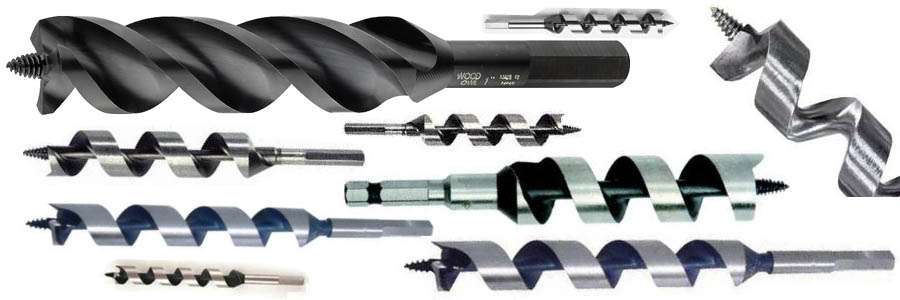
auger point screw --- A screw that has a very sharp point and threads that grip the wood strongly. Such screws often have a the kind of end found on a self tapping screw, and in any case this type of screw is designed to be used with no pilot hole ... it pulls itself into the wood once started. Examples:
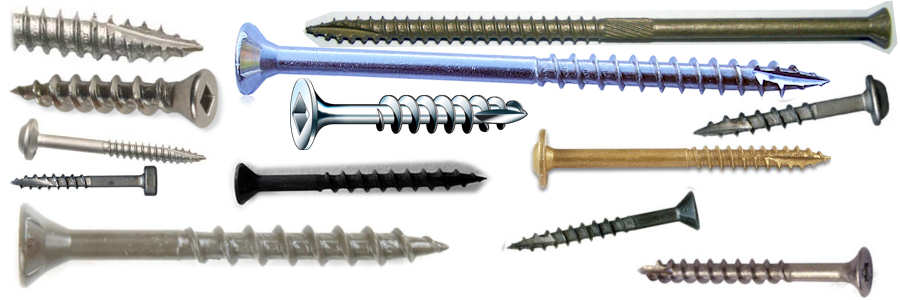
automatic center punch --- synonymous with machinist center punch
auxiliary fence --- A temporary (often sacrificial) fence attached to a tablesaw fence or miter gauge, or to some other machine table, to protect a cutter or bit while providing full workpiece support in an operation that could otherwise damage the regular fence.
awl --- A pointed instrument that looks like an ice pick, designed for poking small holes in leather, rubber, and other flexible materials, so the thread or cord of some kind can be inserted. This is not, technically, a woodworking tool, because there is a version of it that IS a woodworking tool, and that is the scratch awl, used for marking positions by making light scratches (witness marks) when laying out a project. In practice, there is often no significant difference between an awl and a scratch awl, other than where they are sold. They both come in a wide variety, the differences being in the handle style and the thickness of the shaft. Examples:

AWPA --- see American Wood Protection Association
ax --- synonymous with axe
axe --- A tool for chopping trees and splitting and rough-shaping wood. It has a long wooden handle (the helve) with a heavy metal head that has either a single or double-sided blade. Sometimes one side is a cutting edge and the other is a hammer-like surface with which one can pound a splitting wedge. The axe is one of oldest known human tools and in addition to being a tool, it has existed in various forms as both a weapon and as a heraldic symbol of power. Examples of the tool version:

axis --- The line about which an object is rotationally symmetrical. For a tree, this is a line taken from the center of the tree at the bottom to the center of the tree at the top. NOTE: In woodworking terms, a tree has three mutually perpendicular planes or surfaces (tangential, radial, and transverse) that are very important in terms of discussing wood grain and figure and these three planes are sometimes referred to, incorrectly, as the axes of the tree. This happens because it IS mathematically appropriate to talk about these three planes in terms of the standard 3-axis Cartesian co-ordinate system. An axis, however is always a line, never a plane or surface.
for images of wood itself, go here: wood id site
A
B
C
DE
F
GH
IJK
L
M
NO
P
QR
S
T
UVWXYZ
To see general comments about this glossary and for the email address, click here: GLOSSARY
































